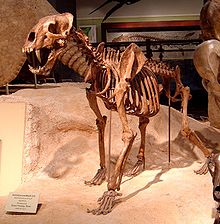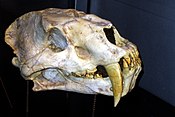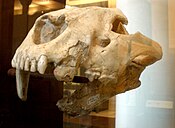Homotherini
| Homotherini Temporal range:
| |
|---|---|

| |
| Skeleton of Homotherium serum from Friesenhahn cave, Texas Memorial Museum, University of Texas at Austin, Austin, Texas | |
| Scientific classification | |
| Domain: | Eukaryota |
| Kingdom: | Animalia |
| Phylum: | Chordata |
| Class: | Mammalia |
| Order: | Carnivora |
| Suborder: | Feliformia |
| Family: | Felidae |
| Subfamily: | †Machairodontinae |
| Tribe: | †Homotherini Fabrini, 1890 |
| Genera | |
Homotherini (Machairodontini) is a tribe (or subtribe)[1] of saber-toothed cats of the family Felidae (true cats). The tribe is commonly known as scimitar-toothed cats. These saber-toothed cats were endemic to North America, Europe, Asia, Africa, and South America[2] from the Miocene to Pleistocene living from c. 23 Ma until c. 12,000 years ago.[3] The evolutionary relationship between the tribes Homotherini and Machairodontini cause paleontologists to classify Homotherini either as a subtribe of Machairodontini, or the same tribe often using either name interchangeably.
Description
[edit]Compared to the usually massively built dirk-toothed phenotype, apparent in Smilodon, Megantereon and the feliform Barbourofelis (just to list a few), their upper canines were smaller than those of equally sized cats of that phenotype, but they had serrated edges.[4][5] The scimitar-toothed phenotype has also evolved independently in other mammal families.[6]
The subtribe Homotherini evolved towards a body style more fit for running, with lighter builds and long legs seen in the genera Lokotunjailurus and Homotherium[7] as well as larger noses for better respiration during pursuit.
The subtribe Machairodontini retained features more similar to extant pantherines, with shorter legs and longer tails than Homotherins, while maintaining saber tooth features such as a longer neck and upper canine teeth that were larger and bladed.[8] Machairodontins had heavier bodies with some species in the genus Machairodus almost reaching the size of Smilodon populator.[9]
Evolution
[edit]Based on mitochondrial DNA sequences extracted from fossils, the lineage of Homotherium is estimated to have diverged from that of Smilodon about 18 Ma ago.[10]
The scimitar tooth form was used to assist in the hunting of herbivorous megafauna. With its hyper sharp and serrated form it was perfect for ripping flesh off of downed prey. However, if this tooth would come into contact with bone it could get caught, serrations worn off, or even completely broken thus leaving the organism without a food source, leading to starvation and death.[11][12]
There is a debate about how both the scimitar-tooth and the dirk-tooth evolved in felines and other mammals. the two sides of the debate revolve around whether it was derived from a sexual dimorphic trait or if it was completely natural selection that drove the creation of these phenotypes. The argument for sexual dimorphic origins stems from the fact that in mammals sexual dimorphic traits manifest as tools for males to compete for females. It is believed that the scimitar-tooth and the dirk-tooth were originally only in males for use in competition but then with the rise of mega-herbivores it became favorable for females to take up the trait as well.[13] The natural selection side of the debate argues that the scimitar and dirk-tooth both evolved because of the unfilled niche of predation of megaherbivores so the trait evolved to take advantage of said niche.[14]
Classification
[edit]| Tribe | Genus | Species | Image |
|---|---|---|---|
| †Homotherini | |||
| †Homotherium Fabrini, 1890 |
|

| |
| †Xenosmilus Martin et al., 2000 |
|

| |
| †Lokotunjailurus Werdelin 2003 |
|

| |
| †Amphimachairodus Kretzoi, 1929 |
|

| |
| †Nimravides Kitts 1958 |
|

|
|
| †Machairodontini | |||
| †Machairodus Kaup, 1833 |
|

| |
| †Hemimachairodus Koenigswald, 1974 |
|
||
| †Longchuansmilus Jiangzuo et al 2022 |
|
||
| †Adeilosmilus Jiangzuo, Werdelin, Sun et al 2022 |
|
||
| †Taowu Jiangzuo, Werdelin, Sun et al 2022 |
|

| |
| †Miomachairodus Schmidt-Kittler 1976 |
|
Phylogeny
[edit]The phylogenetic relationships of Homotherini are shown in the following cladogram:[15][16][17][18][19]
| †Homotherini |
| |||||||||||||||||||||||||||||||||||||||||||||||||||||||||||||||||||||||||||
References
[edit]- ^ Jiangzuo, Q.; Werdelin, L.; Sun, Y. (2022). "A dwarf sabertooth cat (Felidae: Machairodontinae) from Shanxi, China, and the phylogeny of the sabertooth tribe Machairodontini". Quaternary Science Reviews. 284: Article 107517. Bibcode:2022QSRv..28407517J. doi:10.1016/j.quascirev.2022.107517.
- ^ Rincon, A.; Prevosti, F.; Parra, G. (2011). "New saber-toothed cat records (Felidae: Machairodontinae) for the Pleistocene of Venezuela, and the Great American Biotic Interchange". Journal of Vertebrate Paleontology. 31 (2): 468–478. doi:10.1080/02724634.2011.550366. hdl:11336/69016. S2CID 129693331.
- ^ Paleobiology Database: Homotherini Basic info.
- ^ Martin, L.D. (1989). "Fossil history of the terrestrial Carnivora". In Gittleman, J.L. (ed.). Carnivore behaviour, ecology, and evolution. Vol. 1. Ithaca, IL: Cornell University Press. pp. 536–568.
- ^ Van Valkenburgh, B (2007). "Deja vu: the evolution of feeding morphologies in the Carnivora". Integrative and Comparative Biology. 47 (1): 147–163. doi:10.1093/icb/icm016. PMID 21672827.
- ^ Meloro, C.; Slater, G. J. (2012). "Covariation in the skull modules of cats: the challenge of growing saber-like canines". Journal of Vertebrate Paleontology. 32 (3): 677–685. doi:10.1080/02724634.2012.649328. S2CID 55862923.
- ^ Antón, Mauricio (2013). Sabertooth. Bloomington: Indiana University Press. pp. 118–138. ISBN 9780253010421.
- ^ Antón, Mauricio (2013). Sabertooth. Bloomington: Indiana University Press. pp. 118–138. ISBN 9780253010421.
- ^ Bellani, Giovanni G. (2020). Felines of the world: discoveries in taxonomic classification and history. London; San Diego, CA: Academic Press is an imprint of Elsevier. ISBN 9780128172773.
- ^ Paijmans, J. L. A.; Barnett, R.; Gilbert, M. T. P.; Zepeda-Mendoza, M. L.; Reumer, J. W. F.; de Vos, J.; Zazula, G.; Nagel, D.; Baryshnikov, G. F.; Leonard, J. A.; Rohland, N.; Westbury, M. V.; Barlow, A.; Hofreiter, M. (2017-10-19). "Evolutionary History of Saber-Toothed Cats Based on Ancient Mitogenomics". Current Biology. 27 (21): 3330–3336.e5. doi:10.1016/j.cub.2017.09.033. PMID 29056454.
- ^ Van Valkenburgh, B (2007). "Deja vu: the evolution of feeding morphologies in the Carnivora". Integrative and Comparative Biology. 47 (1): 147–163. doi:10.1093/icb/icm016. PMID 21672827.
- ^ Slater, G. J.; Valkenburgh, B. Van (2008). "Long in the tooth: evolution of sabertooth cat cranial shape". Paleobiology. 34 (3): 403–419. doi:10.1666/07061.1. S2CID 85353590.
- ^ Randau, Marcela; Carbone, Chris; Turvey, Samuel T. (August 8, 2013). Evans, Alistair Robert (ed.). "Canine Evolution in Sabretoothed Carnivores: Natural Selection or Sexual Selection?". PLOS ONE. 8 (8). Public Library of Science (PLoS): e72868. Bibcode:2013PLoSO...872868R. doi:10.1371/journal.pone.0072868. ISSN 1932-6203. PMC 3738559. PMID 23951334.
- ^ Van Valkenburgh, B.; Sacco, T. (2002). "Sexual dimorphism, social behavior, and intrasexual competition in large Pleistocene carnivorans". Journal of Vertebrate Paleontology. 22: 164–169. doi:10.1671/0272-4634(2002)022[0164:sdsbai]2.0.co;2. S2CID 86156959.
- ^ "Paleobiology Database". Archived from the original on 2012-03-25. Retrieved 2011-06-16.
- ^ Turner, Alan (1990). "The evolution of the guild of larger terrestrial carnivores during the Plio-Pleistocene in Africa". Geobios. 23 (3): 349–368. doi:10.1016/0016-6995(90)80006-2.
- ^ Martin, L. D.; Babiarz, J. P.; Naples, V. L.; Hearst, J. (2000). "Three Ways To Be a Saber-Toothed Cat". Naturwissenschaften. 87 (1): 41–44. Bibcode:2000NW.....87...41M. doi:10.1007/s001140050007. PMID 10663132. S2CID 1216481.
- ^ Turner, Alan (1997). The Big Cats and their fossil relatives. New York: Columbia University Press. p. 60. ISBN 978-0-231-10228-5.
- ^ Wallace, S. C.; Hulbert, R. C. (2013). Larson, Greger (ed.). "A New Machairodont from the Palmetto Fauna (Early Pliocene) of Florida, with Comments on the Origin of the Smilodontini (Mammalia, Carnivora, Felidae)". PLOS ONE. 8 (3): e56173. Bibcode:2013PLoSO...856173W. doi:10.1371/journal.pone.0056173. PMC 3596359. PMID 23516394.

